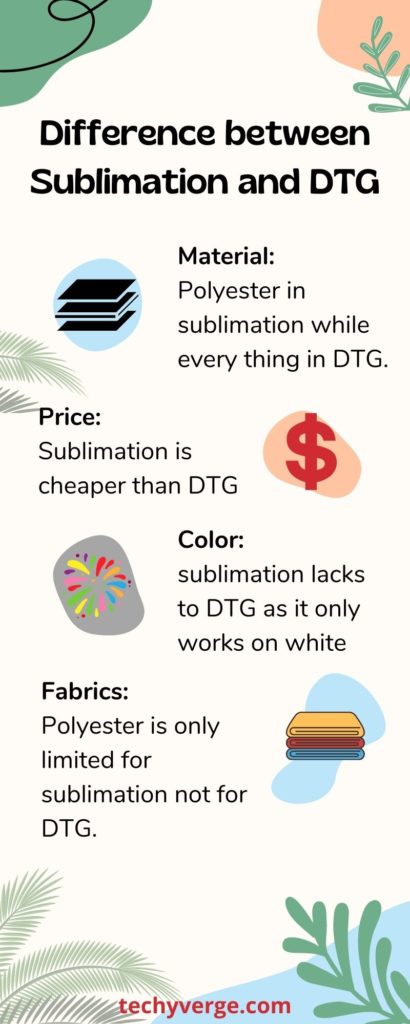There has been unprecedented growth in the printed garment business over the last few years. Dye sublimation and Direct Garment are the primary two sources to run this business.
Let’s take a closer look at these two sources’ major features and functions. That makes them different from each other. This will allow you to choose the best materials to print your design on easily.
The main difference between dye sublimation and direct-to-garment is that Sublimation dyes penetrate the surface of the substrate to recolor it from the inside out, whereas DTG inks cover the surface.
Due to these differences, the chemistry of the two processes differs significantly. Sublimation relies on molecular bonding, while DTG relies on adhesion to the surface.
Let me briefly introduce dye sublimation and digital transfer printing as a starting point. Knowing their works, you can perfectly print on materials using both sources.
What is DTG Printing?
The full form of DTG is Direct To Garment. It is also known as digital printing because it involves a unique process. Using water-based ink technology allows textiles to be printed.
So that it can easily make prints on cellulose-based fibers as well as polyester materials, it is an old technique and forces the screen through the screen onto the surface of the materials.
How Does DTG Work?
This DTG printing process is not like those simple and cheap iron-on transfers. It means that it will not break after a single washing and drying process.
The DTG printing includes its inkjets. That can inject ink during the printing process. These prints are combinations of Epson-like printers and water-based inks.
The design can be created in more than one color this way. Which makes your print occur on nearly every material available.
The design can be created in more than one color this way. Which makes your print occur on nearly every material available. The most common material used in printing processes is local T-shirts. They can also be used to print on materials like cotton, polyester, metals, canvas, and much more.
You can easily print more than 16 million colors in your designs to make your print look more attractive. All its printing methods are usually the same as the sublimation process. However, you must first pass them through a heating unit to create a permanent impression of your image on the materials.
What is Dye Sublimation?
Dye sublimation is a little more complex process than DTG. In this process, the sublimation ink is first sublimated directly from its solid to its gas form.
These gas vapors are then allowed to attach to the surface of the materials. Polyesters are the only materials on which sublimation is easily performed. However, polyester coatings can also allow sublimation.
This process only takes place in the presence of high pressure and temperature. This condition is suitably adjusted by the heat press present in these sublimation printers.
How Does Dye Sublimation Work?
Dye sublimation involves using sublimation printers, papers, inks, heat presses, and sublimated materials.
First, the design is placed on the transfer papers that pass through the heat press. This heat press changes the ink directly into its gas form. This takes place at a temperature of 400F for about 50s. As the paper is passed through a heat press, these vapors are permanently attached to the surface of your materials.
As a result, your design is completely printed on your material. The primary material used for this process is polyester. But, if some materials are used other than polyester, then you can use polyester coatings on them.
Main Difference between Dye sublimation and DTG
Several features and functions differentiate the two processes of Dye sublimation and direct to garment. We will describe the most important characteristics that make them special.
1. Materials
DTG works on all-natural fibers. These may include wood, bamboo sticks, metals, and many more. They do not require special coatings for printing on various materials.
On the other hand, dye sublimation only works on a few materials. But, the most important material present in this is Polyester. Polyester can easily bond with the incoming ink to create the perfect quality designs.
If polyester is unavailable or not present, then it is impossible to sublimate over any material. First, you must always produce polyester coatings on every material surface so you can easily sublimate to them.
2. Colour of the materials
Talking about the functions of the Dye sublimation process, it only works on some specific colored materials. These materials must be either white or light-colored to be perfectly sublimated.
Sublimation can not be done on dark-colored materials easily. However, you can perfectly print your designs on dark-colored materials by using DTG. It generally has no color limitations.
3. Price
The next significant difference between these two printers is their cost/price. In general, the function of both printing processes is the same. Even the quality of images that these processes produce is unique.
However, their prices have a lot of differences compared to each other. The Dye sublimation is much cheaper and more affordable as compared to DTG. Normally, it costs you around $1000-$15000.
On the other hand, the DTG is very expensive. It ranges from $15000-$250,000. Thus, people can not buy this type of printing process because of its high price.
Dye Sublimation Vs DTG

FAQs
Yes, DTG is better than the dye sublimation process when they are compared. This is because the DTG can work on all-natural fabrics.
Both of these processes are the same, and they have similar functions. However, it includes the use of hot glue, which is not present in the Dye sublimation process.
It generally depends upon the use of the ink. If the ink used is not good in quality, then the chance of fading of prints from your materials increases to a high rate.
- Can You Sublimate on Nylon and Polyester? Which oneis the Best - February 19, 2024
- Converted Epson Eco Tank Et-2800 Vs Et-2803 Sublimation Printer [Review 2024] - February 19, 2024
- Can You Reuse Sublimation Prints? (The Righ Answer) - February 19, 2024



![Top 100+ FAQs Related to Sublimation Printing & Heat Press [Updated 2024] faqs related to sublimation Printing](https://www.techyverge.com/wp-content/uploads/2022/08/faqs-related-to-sublimation-Printing--150x150.jpg)


